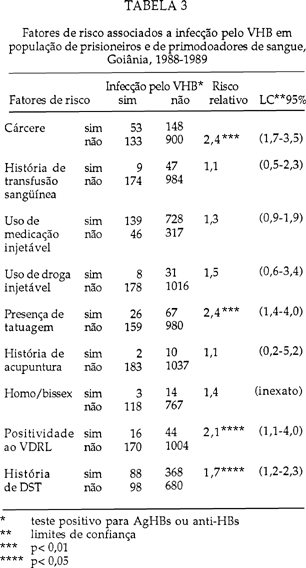Two cross-sectional surveys on hepatitis B virus (HBV) infection were carried out among 1,033 volunteer first-time blood donors in five blood banks (3 private, 2 public) and among 201 prisoners in the Penitentiary Center of Industrial Activity, in Goiânia, Central Brazil, between June 1988 and February 1989. Those surveys were part of a major study designed to estimate seroprevalence of HBsAg and anti-HBsAg markers by ELISA test, and to study risk factors associated with seropositivity. The presence of any serum marker was considered as previous exposure to HBV. A standard questionnaire was applied to both populations to evaluate previous blood transfusion, number of sexual partners, homo/bisexual activity, history of sexually transmitted diseases, drug abusers, use of parenteral medicine, accupunture, tattooing and VDRL seropositivity. Seroprevalence varied from 12.8% to 26.4% in blood donors and prisoners, respectively, (p<0.05) and increased with age (X² trend=14.0 p<0.05%). Prisoners had higher percentages of all risk factors investigated than blood donors, with the exception of number of sexual partners. Among all risk factors studied, age, imprisonment and tattooing were statistically associated with seropositivity, even after multivariate analysis controlling for age and reclusión. The paper discusses the methodologic issues related to this epidemiologic investigation.
Hepatitis B; Serodiagnosis; Risk factors; Blood donors; Prisoners



